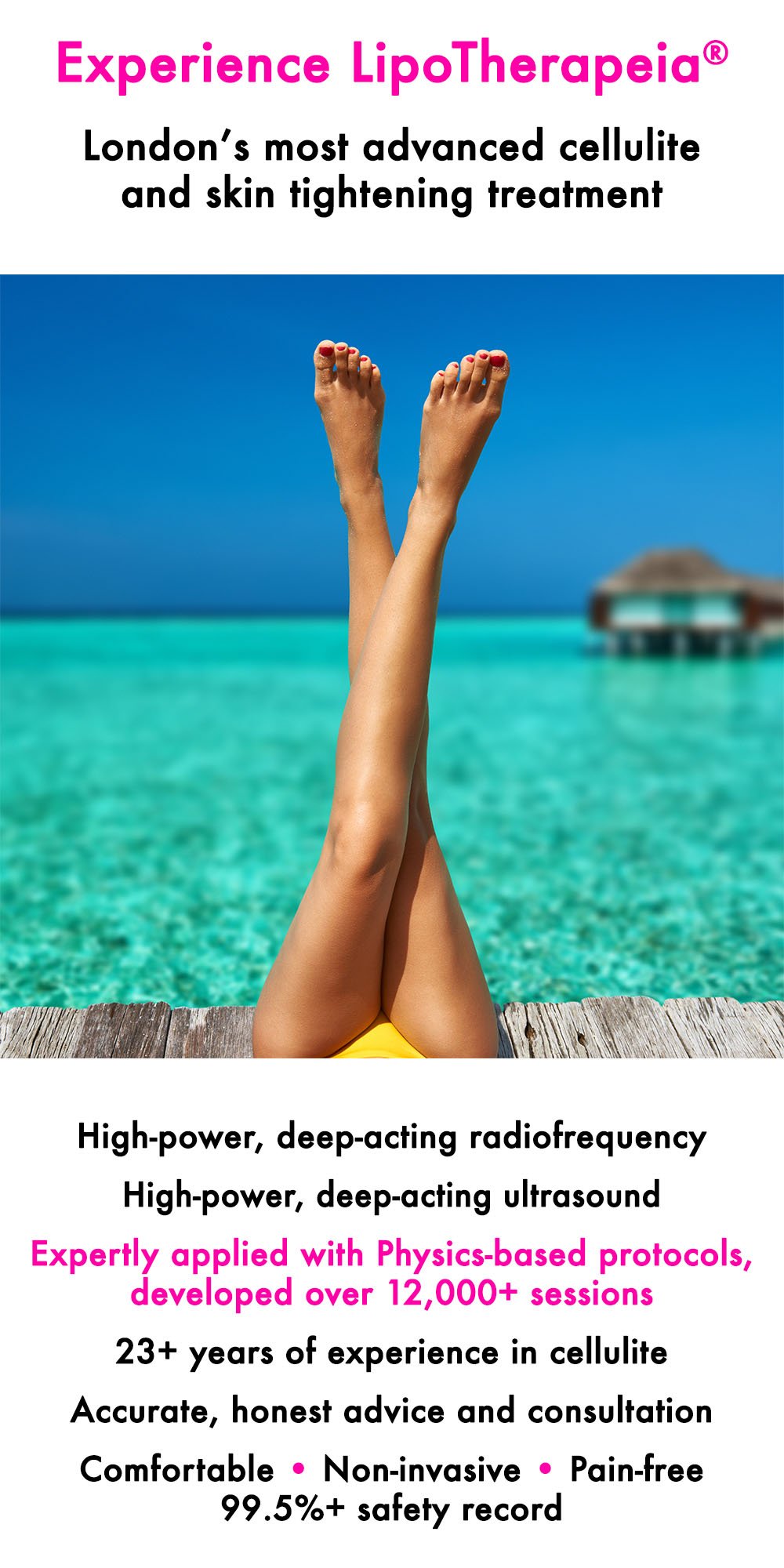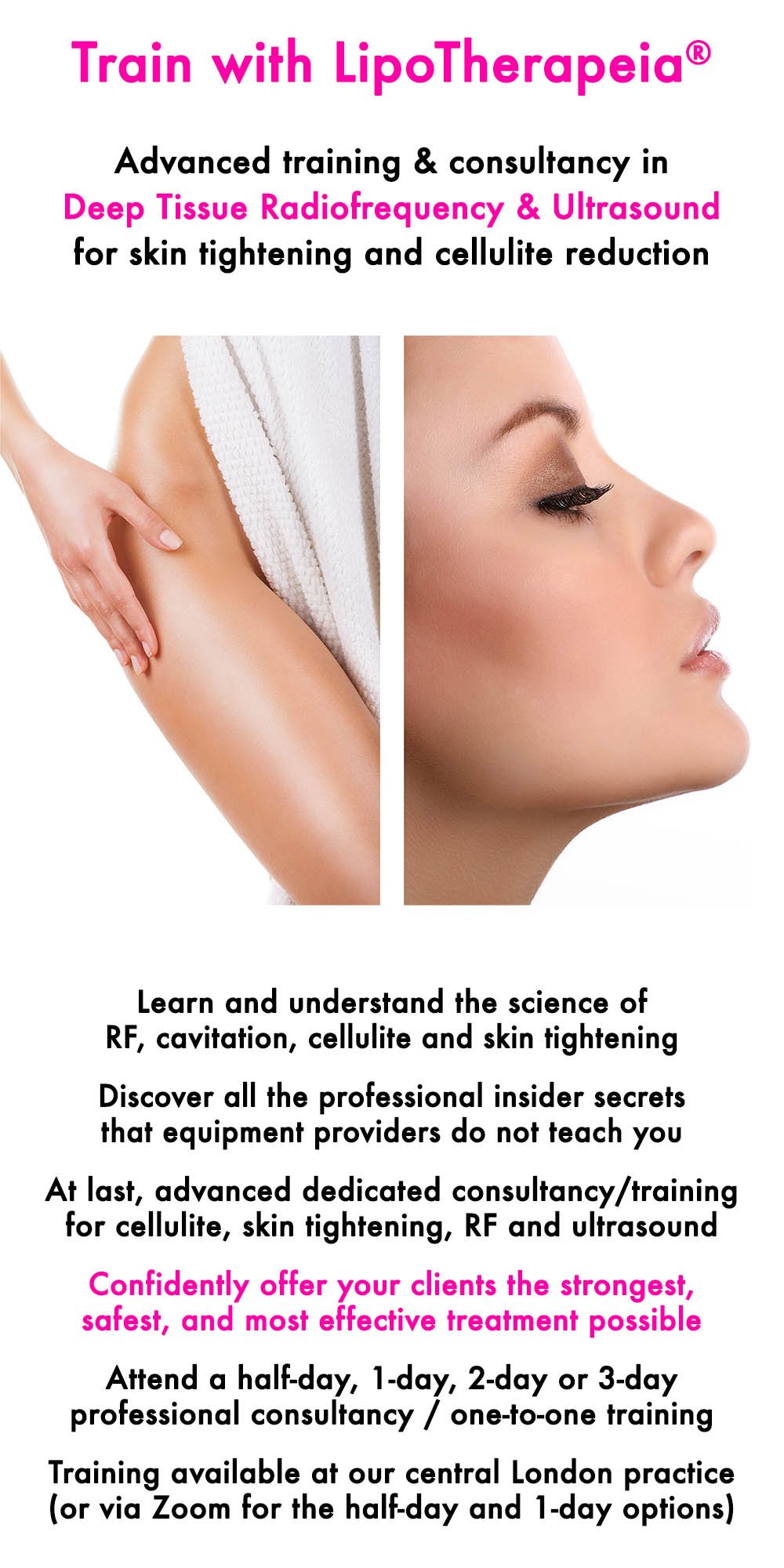Cavitation / radiofrequency gone wrong: too much, too little, too deep, too superficial… | The Pro Series
‘The Pro Series‘ present different aspects of our advanced professional training and consultancy courses, available via Zoom or at our aesthetic practice in London. If you are a professional, learn more about our training courses here. Just came to this page looking for cellulite / skin tightening treatment? Book a treatment at our London practice here.
Ultrasound, radiofrequency and tissue depths
When ultrasound / RF is applied too superficially
When RF / cavitation is applied too deeply
Trying too hard / taking too many risks / thinking one is too smart
Knowing which tissue is located at which depth and which equipment/setting can reach that depth is essential
The right technology at the right depth and right intensity
Ultrasound, radiofrequency and tissue depths
We have specialised in skin tightening and cellulite for more than two decades and over the years we have assessed practically and theoretically all relevant technologies, including the biggest current gimmicks, i.e. HIFU and RF microneedling.
After all these years we have found that deep-acting, high-power radiofrequency and high-power ultrasound cavitation are by far the strongest SAFE technologies for skin tightening and cellulite and that’s why we use them at the clinic and teach their application to other therapists and clinic owners.
However, not all cavitation and RF treatments are the same. In fact…
as every clinic individual therapist practises those technologies differently, even with the exact same equipment
and as there is a huge variety of RF and ultrasound equipment on the market, ranging from very low spec to very high spec
…we can say that there are as many RF/cavitation treatments on the market as there are clinics in the world - probably tens of thousands of them.
So radiofrequency and cavitation treatment can be:
Spot-on, when it is applied at the right mix, at the right intensity and when focusing at the right skin depth for each specific indication and person
Ineffective, when it is of too low intensity and/or applied at the wrong skin depth
Unsafe, when it is of too high intensity and/or applied at the wrong skin depth
The whole picture is further complicated by the widespread ignorance regarding:
How deeply the different anatomical structures are located, i.e. epidermis, dermis, hypodermis, SMAS (superficial musculoaponeurotic system), superficial fascia, intermediate fascia, deep fascia and subcutaneous adipose tissue (commonly mistaken even by most aesthetic doctors, let alone beauty therapists).
(For example, I have been told recently by a HIFU equipment “clinical” trainer that 4.5mm is where the dermis is and that 9mm is where cellulite is. Both were totally off, of course, by several millimetres.)
How deeply different technologies reach or should reach (commonly mistaken even by equipment manufacturers themselves, let alone machine buyers)
Let’s now see in detail what happens in different scenarios where treatment depth and/or treatment intensity are wrong.
When ultrasound / RF is applied too superficially
When treatment is applied too superficially (usually on the epidermis or superficial dermis) we may have:
either poor results (if intensity is not too high)
or skin injury (if intensity is too high)
This usually manifests as crepey skin, paper-thin skin or a skin burn.
Such skin injury usually occurs with RF microneedling and HIFU but it can also occur with ultrasound or RF, when used by poorly trained therapists, the wrong protocols or poor equipment.
When RF / cavitation is applied too deeply
When treatment is applied too deeply (usually on the subcutaneous adipose tissue on body and face; or adipose tissue around the SMAS on the face) we may:
also have poor results (if intensity is not too high)
or fat tissue / connective tissue injury (if intensity is too high)
This usually manifests as:
a “bump” (temporary mild swelling due to a deep fat/other tissue burn
an externally visible burn/inflammation (more serious deep fat/other tissue burn)
skin hardness/fibrosis (more serious deep fat/other tissue burn)
skin laxity (more serious deep fat/other tissue burn)
fat loss (facial fat loss can be devastating for some people but butt fat loss is also usually unwanted)
Such skin injuries usually occur with RF microneedling and HIFU but they can also occur with ultrasound or RF, when used by poorly trained therapists and/or with the wrong protocols and equipment.
Trying too hard / taking too many risks / thinking one is too smart
Many therapists are too enthusiastic and tend to think that the stronger the treatment the better the results, trying to impress their clients while disregarding safety.
Similarly, many machine manufacturers also make machines that attempt to to “get rid of” cellulite or skin laxity in 1-4 very painful, very dangerous and very expensive sessions (of course, this never, ever happens).
The attitude of both is equivalent to someone trying to do an 100kg bench press when they can normally lift only 60kg. In both cases it is just not going to work. The best outcome of such attitude is failure and the worst outcome is injury. It is just plain stupid.
Proper RF / cavitation works as gym training for the skin and that necessitates multiple regular sessions, not the equivalent of one super-strong, super-risky gym session.
Nature doesn’t work like that and trying to violate nature by deliberately causing an injury (“controlled” tissue burn at 60-90ºC) with the hope that the body will respond with better quality tissue is just reckless.
So, in terms of intensity, the safe AND effective way is to use the exact right level of power - not too strong to cause adverse reactions and not too light to render the treatment ineffective.
This depends both on equipment choice and good training.
I have seen people who have one of our machines at the clinic using the machine in totally the wrong way, and consequently making treatment both painful AND ineffective (it takes a special kind of bad training to achieve that)
And I have seen people doing a pretty good job with lesser equipment, just because they have had better training
Knowing which tissue is located at which depth and which equipment/setting can reach that depth is essential
There is huge confusion about the names of the different tissue layers and their location within the skin, even between different experts.
The picture is further complicated by the fact that many of those tissue layers are thinner in some areas and thicker in some others, even on the same person.
Some skin layers have a different structure on different body areas and on different people. And some are missing altogether or fuse with each other in different body areas.
If you apply a decent treatment intensity the worst thing that can happen by getting the depth wrong is just reduced treatment effectiveness. Not great but at least not a disaster.
However, if you apply extreme intensity (as in the instant miracle procedures mentioned above that attempt to give results in 1-4 sessions) then getting your skin layers wrong can be disastrous. This is usually the case with therapists targeting the SMAS on the face (i.e. the tissue depth facelift surgeons work on) with high intensity RF microneedling, high intensity HIFU or extreme intensity RF.
In these cases, if things go wrong people lose facial fat or get swelling/burns/fibrosis. This is because the SMAS is located at different skin depths even in the same person and because no equipment accurately targets the same specific depth in all people and even in all different anatomical areas of the same person.
A depth of 1.5mm can be on facial fat on one part of someones’s face and on the SMAS on another part of the same person’s face. Just a difference of 0.5mm can lead to disaster and it is easy to get things wrong.
The only reason there not that many disfigured people with such treatments is usually due to treatment intensity being too low to cause damage (but also too low to offer the promised miraculous results, which are usually so-so, despite all the pain and expense). Also, some people’s fat/connective tissue is more resilient, despite the extreme intensity applied at the wrong place. And in some cases sheer luck helps avoid adverse reactions too.
The right technology at the right depth and right intensity
All in all, by knowing:
which technologies to combine (ultrasound, RF, phototherapy etc) for each indication (skin firmness, anti-ageing, cellulite etc)
how to target the correct treatment depths
how to recognise when intensity is too low or too high for different people and different body areas on the same person
…one can offer the most effective treatment possible with a:
realistic number of sessions: usually 6-12 sessions (and definitely not 2-3 neither 20-30)
great safety profile: currently 99.5%+ at our clinic (with the 0.5%- of the cases being temporary and/or mild irritation, i.e. insignificant)
And this is what we teach at LipoTherapeia.
Now you can get instant access to this expertise and save yourself literally thousands of $$$/£££ of expensive mistakes and thousands of hours of study, research and practical application by attending one of our 1-day or 2-day or 3-day professional consultancy / training courses.
Understand radiofrequency, ultrasound cavitation, cellulite and skin tightening deeply and confidently offer your clients the safest, strongest and most effective treatment possible.
Service available via Zoom or at our central London practice.





